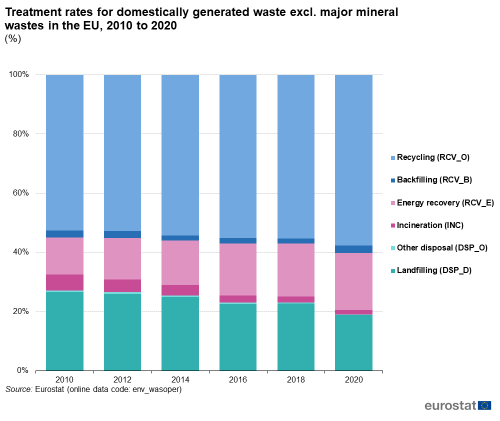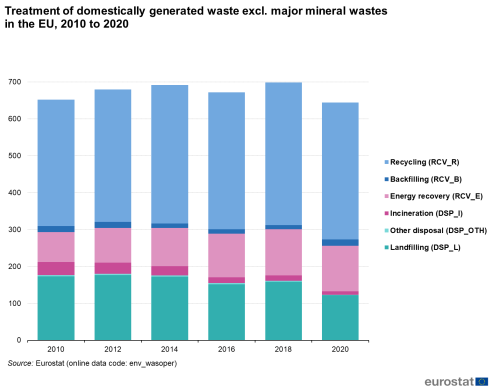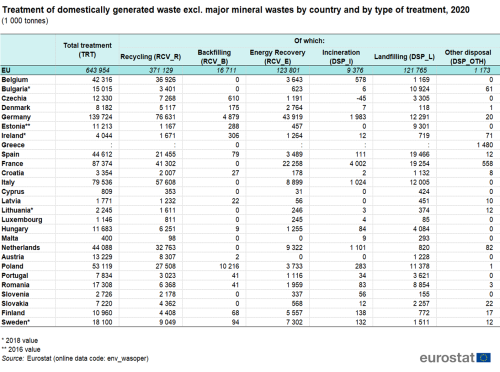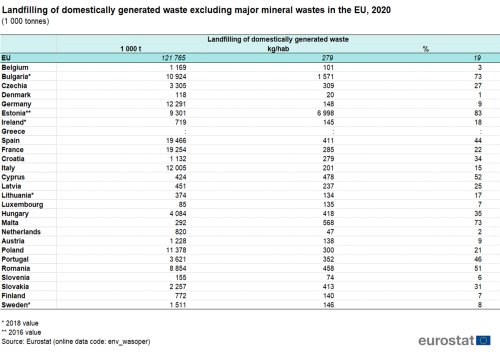Waste management indicators
Data extracted in November 2022.
Planned article update: November 2024.
Highlights

(%)
Source: Eurostat (env_wasoper)
EU waste policy aims at establishing a circular economy where materials and resources are maintained in the economy for as long as possible and where the disposal of waste is the last option of waste management. This new set of waste management indicators provided by Eurostat is a way to monitor progress towards more recycling and less disposal.
The set of indicators on the ‘management of waste excluding major mineral wastes’ measures how waste generated in the EU as a whole and in individual Member States is finally treated, whether in the European Union (EU) / EU Member States or abroad. The indicator set reflects the treatment rates of the waste produced in a given country by type of treatment.
Full article
Overview
The waste management indicator set combines treatment data collected under Regulation (EC) No 2150/2002 (WStatR) with import/export data from international trade statistics (COMEXT database) or from national sources. WStatR treatment data provide information on the amounts of waste that are managed in Member States, no matter in which country the waste is generated. Hence, the amount of treated waste reported by country A excludes the waste that arises in country A but is treated in country B (e.g. because appropriate treatment facilities are lacking). However, it may include waste imported from country B for treatment. In order to link the treatment data to the domestically generated waste the WStatR data are adjusted for imports and exports by means of trade statistics according to the formula:
Amount of domestically generated waste treated =
Waste treated in country (WStatR data) + Waste exported for treatment (COMEXT data) - Waste imported for treatment (COMEXT data)
The indicators are expressed in volumes of treated waste by treatment category as a proportion of the total amount of domestically treated waste. The indicator set comprises treatment rates for the six treatment categories defined in WStatR (see Table 1).
The set of indicators covers waste from all economic sectors and from households but excludes some mineral waste types that arise in large quantities and originate mainly from the mining and the construction sector.
Table 1 illustrates the calculation of the waste management indicators and shows the results for the EU for reference year 2020, broken down by type of treatment.According to WStatR data, in 2020 a total of 634 million tonnes of waste excluding major mineral wastes were treated in the EU. This amount includes waste imports from outside the EU of 82 million tonnes but does not cover 92 million tonnes of waste that leave the EU for treatment in non-EU countries. Overall, the EU is a net exporter of waste with net exports amounting to 10.2 million tonnes. Exports to non-EU countries mainly consist of metal wastes, paper and cardboard wastes, plastic wastes and other wastes for recycling.
The adjustment for imports and exports results in a total of 644 million tonnes of domestically generated waste excluding major mineral wastes (see column 6 in Table 1). Overall, 57.6 % or 371 million tonnes of the domestically generated waste were recycled. Energy recovery accounted for 19.2 % or 124 million tonnes and waste incineration for 1.5 % or 9 million tonnes of waste. 122 million tonnes or 18.9 % of waste were landfilled; 0.2 % of waste was disposed by other means.

(1 000 tonnes, %)
Source: Eurostat (env_wasoper)
Figure 1 shows the treatment of domestically generated waste for the EU from 2010 to 2020; the corresponding treatment rates are shown in Figure 2. The total amount treated decreased from 652 million tonnes in 2010 to 644 million tonnes in 2020. The recycled amount has grown between 2010 and 2020 by 28 million tonnes, consequently, the recycling rate increased to 58 %. Energy recovery has also been on the rise since 2010 with an increase of 43 million tonnes. The share of energy recovery grew accordingly from 12 % to 19 %. A part of this increase is presumably caused by the reclassification of waste incineration plants pursuant to the energy efficiency criterion set out in the Waste Framework Directive. This partly explains the decrease of waste incineration without energy recovery between 2010 and 2020 by 26 million tonnes. The increase of recycling and energy recovery resulted in a diversion of waste from landfills. The landfilled amounts decreased from 2010 to 2020 by 51 million tonnes resulting in a landfill rate of 19 % in 2020.

(million tonnes)
Source: Eurostat (env_wasoper)

(%)
Source: Eurostat (env_wasoper)
Table 2 shows the treatment of domestically generated waste by EU Member State and by type of treatment for the year 2020 in tonnes. The heights of the columns in figure 1 reflect the treated amounts of domestically generated waste for each country; the segments display the amounts by type of treatment. Table 2 shows that the treated amounts of waste excluding major mineral wastes per inhabitant vary considerably across countries, reflecting differences between them in economic structure, in energy production and in consumption. The treatment rates have to be evaluated against the background of the Member States’ economic structures. Results of ranking by treatment rates should not be overvalued.

(1 000 tonnes)
Source: Eurostat (env_wasoper)
Recycling
The recycling rate is highly relevant for measuring progress towards a circular economy. In 2020, the EU as a whole recycled 58 % of domestically generated waste, which corresponds to 835 kg per inhabitant. Metal wastes (EWC-Stat 06), animal and vegetal wastes (EWC-Stat 09) and paper and cardboard wastes (EWC-Stat 07.2) account for more than half of recycled waste. Combustion wastes (12.4), wood wastes (07.5), mineral wastes from waste treatment (EWC-Stat 12.8, 13) and glass wastes (EWC-Stat 07.1) account for another quarter of the total for recycling.
In Member States, the recycling rates vary between 87 % in Belgium and Slovenia and 10 % in Estonia (see Table 3). Apart from Slovenia and Belgium seven countries reported recycling rates of 60 % and more: Lithuania, Italy, Portugal, Luxembourg, Czechia, Austria and Denmark. When related to population, the recycled amounts are highest in Belgium, Luxembourg and the Netherlands.
In countries with a waste intensive energy production, the overall recycling rate is highly dependent on the management of the energy related waste types.

(1 000 tonnes, kg/inhabitant, %)
Source: Eurostat (env_wasoper)
Landfilling
Landfilled waste represents an enormous loss of resources in the form of both materials and energy and so should be limited as far as possible. At EU-level, the landfilling of waste has been continuously reduced in recent years and amounted to 125 million tonnes or 19 % of domestically generated waste in 2020. When related to population, 279 kg per inhabitant of waste excluding major mineral wastes were landfilled on average in the EU.
The landfill rates vary widely across Member States reflecting the differences in the waste management systems in general and the policies towards landfilling in particular. An increasing number of Member States introduced landfill bans for recyclable, combustible or untreated waste and economic incentives to divert waste from landfills. The success of these measures is evident in countries such as Denmark, the Netherlands, Belgium, Slovenia, Finland, Sweden, Luxemburg, Germany and Austria, which disposed of less than 10 % of domestically generated waste in landfills.

(1 000 tonnes, kg/inhabitant, %)
Source: Eurostat (env_wasoper)
Incineration
Incineration and energy recovery are essential components of waste management in numerous Member States, in particular in the Nordic countries Finland, Sweden and Denmark, where between 34 % and 52 % of domestically generated waste was incinerated in 2020. In Finland, incineration is particularly high due to the large quantities of wood wastes. Incineration comprises the use of waste as fuel (R1), mainly in power plants and cement kilns, and the thermal treatment of waste for disposal with the aim of reducing the volume and/or the hazardousness of the waste (e.g. incineration of health care waste).

(1 000 tonnes, kg/inhabitant, %)
Source: Eurostat (env_wasoper)
Source data for tables and graphs
Data sources
The set of waste management indicators is based on waste treatment data collected under Regulation (EC) No 2150/2002 on waste statistics (WStatR). The data are adjusted for imports and exports using international trade statistics (COMEXT data) or national data on imports and exports of waste. The indicator set is available for every second year starting with reference year 2010 and covers the 28 EU Member States.
The indicator set covers both non-hazardous and hazardous waste from all economic sectors and from households. However, it excludes the mineral waste categories mineral wastes from construction and demolition (EWC-Stat 12.1), other mineral wastes (12.1, 12.3, 12.5), soils (12.6) and dredging spoils (12.7), which account for around two thirds of the total waste in the EU and mainly originate from mining and construction.
The waste management indicators are published by Eurostat as a pilot data set. They are considered as good approximations for the treatment of domestically generated waste but have some limitations, as follows:
- The Combined Nomenclature (CN) used for international trade statistics does not consistently distinguish between wastes and goods, i.e. some CN-codes cover not only wastes but also non-wastes (by-) products.
- Trade statistics give information on the geographical destination of the waste but not on type of treatment at the place of destination. Hence, the type of treatment is based on assumptions.
- If calculated at country level, additional limitations result from the fact that the statistics on intra-EU trade do not cover 100 % of the traded goods/wastes because of reporting thresholds.
Context
EU waste management policies aim to reduce the environmental and health impacts of waste and improve Europe’s resource efficiency. The long-term goal is to turn Europe into a recycling society, avoiding waste and using unavoidable waste as a resource wherever possible. The aim is to achieve much higher levels of recycling and to minimise the extraction of additional natural resources. Proper waste management is a key part of ensuring resource efficiency and the sustainable growth of European economies. For more information, see circular economy. To achieve this goal, the revised Directive 98/2008 of 2008 introduced a five-step waste hierarchy where prevention is the best option, followed by re-use, recycling and other forms of recovery, with disposal such as landfill being the last resort.
Waste management is the second largest contributor to employment growth in the environmental economy, as shown by environmental goods and services (EGSS) accounts.
Direct access to
- Waste (env_was), see:
- Waste management by waste operations (t, %) (env_wasoper)
- Waste management by waste operations and waste flow (t) (env_wasflow)
- Waste management by waste operations (ESMS metadata file — env_wasoper_esms)
- Regulation (EC) No 2150/2002 of 25 November 2002 on waste statistics
- Summaries of EU legislation: Waste statistics